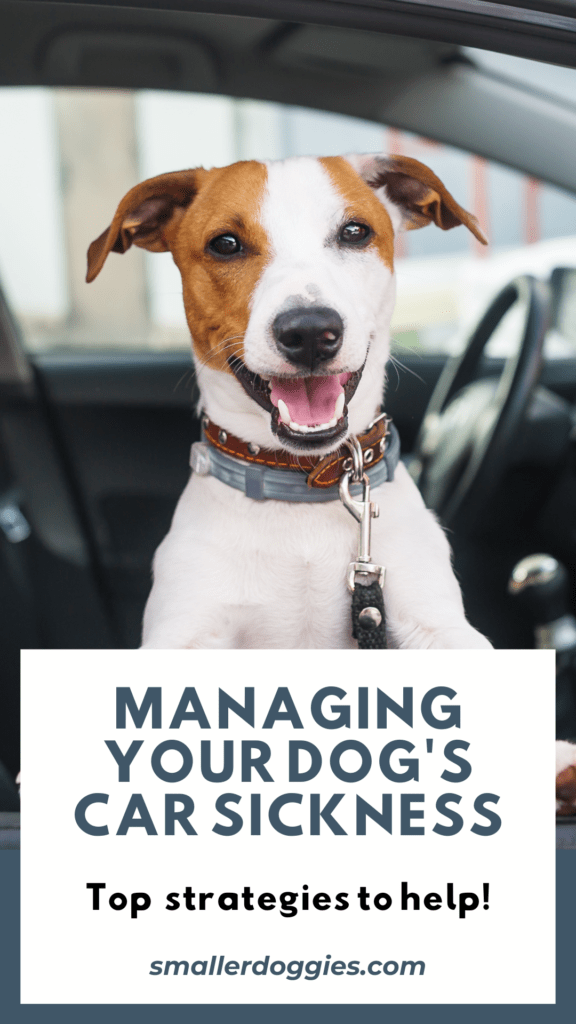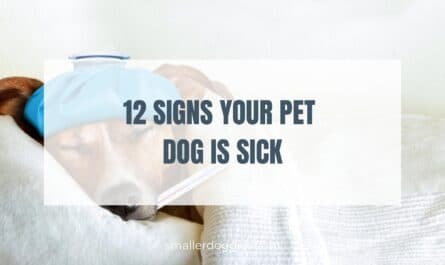Post Disclaimer
This post may contain affiliate links. If you use these links to buy something we earn a commission at no extra cost to you. Smaller Doggies is supported by its audience, Thank you!
Does your dog dread car rides? You’re not alone. Many dogs suffer from car sickness, making every trip stressful for you both. Some simple strategies can help manage your dog’s car sickness effectively.
You don’t have to cancel your road trips. From offering the right food before travel to using calming techniques, there are practical steps you can take. Certain medications can also provide relief, making journeys more comfortable for your pet.
Focusing on your dog’s comfort can make a world of difference. Understanding and implementing these strategies can transform travel time into enjoyable moments. Follow these tips, and watch your dog become a happy traveler.

Table of Contents
- Understanding Car Sickness in Dogs
- Preventative Measures Before Travel
- Management Strategies During the Trip
- Long-Term Solutions and Treatments
- Frequently Asked Questions
Understanding Car Sickness in Dogs
Car sickness in dogs can be a frustrating problem. To help your dog, it’s important to know the causes of motion sickness and how to spot the signs and symptoms.
Causes of Motion Sickness
Motion sickness in dogs often happens for several reasons. Young dogs can be more affected because their inner ears, which help with balance, are not fully developed. Anxiety and stress about car rides can also trigger sickness.
Some dogs may become nauseous because of the motion itself. The inner ear sends mixed signals to the brain, causing discomfort. This is similar to what humans feel. If the dog’s environment in the car is too stuffy or smells bad, this can also make them feel queasy.
Hunger or a full stomach can make a difference too. A dog that eats right before a trip might get more easily sick. Keep in mind that each dog is different, and what causes one dog to feel sick might not affect another.
Identifying the Signs and Symptoms
Recognizing the signs of car sickness can help you act quickly. One obvious sign is excessive drooling. If your dog is drooling more than usual, they might be feeling sick. Another symptom is panting. Dogs pant when they are uncomfortable or anxious.
You might also notice your dog whining or pacing in the car. These behaviors show that they are not comfortable. Vomiting is a clear sign, but there are more subtle symptoms to watch for. Your dog might lick their lips frequently, showing nausea.
Watch their posture, too. Dogs feeling sick often look uneasy, lie down, or seem tired. Paying attention to these signs helps you know when to give your dog breaks or other comfort measures.
Preventative Measures Before Travel
To make car rides easier for your dog, there are several important steps you can take. These steps include getting your dog used to car rides and managing their food and exercise before travel.
Conditioning Your Dog for Car Rides
Getting your dog comfortable with car rides can make a big difference. Start by letting them explore the car while it’s parked. Allow them to sniff around and get familiar with the space.
Next, try short trips around the block. Gradually increase the length of the car rides. During these trips, keep the environment calm and quiet. Use a crate or dog seat belt for safety and security. Give treats and praise to create positive associations.
If your dog shows signs of anxiety, take a step back and slow things down. Patience is key. Consistent practice helps build confidence and reduce stress during longer journeys.
Pre-Travel Feeding and Exercise
Feeding and exercise play a crucial role in managing car sickness. Avoid feeding your dog a large meal before traveling. Instead, offer a small, bland snack about 3–4 hours before the trip. This can help minimize nausea and vomiting.
Before the car ride, take your dog for a walk or play session. Physical activity helps burn off excess energy and can make them feel more relaxed.
Make sure your dog drinks enough water but avoid letting them drink too much. A well-hydrated dog is less likely to experience discomfort.
Management Strategies During the Trip
Taking steps to ensure your dog’s comfort and reducing their stress are key to managing car sickness. Focus on these areas to make the journey smoother.
Creating a Comfortable Environment
Your dog’s comfort is essential. Keep the car at a comfortable temperature. Use a pet seat belt or crate to limit your dog’s movement. This helps prevent sudden movements that can cause nausea. Make sure:
- They can see out the window, as watching the horizon may help.
- You provide a familiar blanket or toy for comfort.
Stopping for breaks every couple of hours also helps. Let them stretch and get fresh air.
Techniques to Reduce Stress and Anxiety
Stress can worsen car sickness. Before trips, try short drives to help your dog get used to the car. During the trip:
- Use calming aids: Pheromone sprays or anxiety vests can be helpful.
- Speak soothingly: A calm voice can reassure your dog.
- Play soft music: This can have a calming effect.
Consider consulting your vet about anti-anxiety medications if needed. Reducing stress will make the trip easier for both you and your dog.
Long-Term Solutions and Treatments
For long-term solutions to manage your dog’s car sickness, consider making dietary adjustments and consulting with a veterinarian. These steps will help provide a stable and lasting improvement in your dog’s condition.
Dietary Adjustments and Supplements
Changing your dog’s diet can help reduce car sickness. Feed your dog a light meal a few hours before traveling. Avoid large, heavy meals right before the trip.
Consider incorporating ginger into your dog’s diet, as it can alleviate nausea. You can give your dog ginger treats or small amounts of ginger powder.
Supplements such as digestive enzymes and probiotics can support your dog’s stomach health. These can be found in pet stores or through your veterinarian. Herbal remedies like chamomile can also calm your dog’s nerves. Be sure to introduce any dietary changes gradually and monitor how your dog responds.
Consultation with a Veterinarian
A veterinarian can provide specialized advice and treatments tailored to your dog’s needs. They may prescribe medications that help reduce nausea and anxiety during car rides.
Regular check-ups will ensure your dog remains healthy and can help adjust treatments as needed. Your vet might also suggest behavioral training or techniques that desensitize your dog to car travel. In some cases, a veterinary behaviorist might be recommended for more severe cases of car sickness.
Discuss different treatment options with your vet to find the best solution for your dog.
Frequently Asked Questions
How can I prevent car sickness in puppies?
Make sure your puppy travels on an empty stomach. Schedule a long walk before the car ride. Keep the car well-ventilated and use a crate to help your puppy feel secure.
How long does dog motion sickness typically last?
Most dogs outgrow car sickness by the time they are one year old. For those who don’t, symptoms usually improve a few minutes after the car stops moving.







